Thermal Mitigation of the Indoor and Outdoor Climate by Green Curtains in Japanese Condominiums
Abstract
:1. Introduction
1.1. Overview of the Study
1.2. Previous Studies of Green Curtains in Japan
1.3. The Objectives of this Study
2. Research Methodology
2.1. Studied Area and Climate
2.2. The Representative of Housing Stock in Japan
2.3. Studied Building and Profile of Households
2.4. Thermal Measurement
3. Results and Discussion
3.1. Comparison of the Globe Temperature with Air Temperature in the Balcony
3.2. Balcony Temperature in Various Stages
3.3. Influence of Air-Conditioner-Usage Time and Balcony Temperature by a Green Curtain
3.4. Indoor and Balcony Thermal Environment With and Without Air-Conditioner Usage
3.5. Comparison with Other Studies
4. Conclusions
- (1)
- The thermal mitigation effect of the green curtain significantly increased from the 1st stage to the 3rd stage;
- (2)
- The air-conditioner-usage time of the households with green curtains was 40% less than that of the households without green curtains;
- (3)
- The balcony globe temperature of the households with green curtains was 0.6 °C lower than that of the households without green curtains, during the air-conditioner usage;
- (4)
- If the balcony temperature is lower than the indoor air temperature, the air-conditioner usage is significantly lower in households with green curtains.
Author Contributions
Funding
Acknowledgments
Conflicts of Interest
References
- Kontoleon, K.; Eumorfopoulou, E. The effect of the orientation and proportion of a plant-covered wall layer on the thermal performance of a building zone. Build. Environ. 2010, 45, 1287–1303. [Google Scholar] [CrossRef]
- Perini, K.; Ottelé, M.; Fraaij, A.; Haas, E.; Raiteri, R. Vertical greening systems and the effect on air flow and temperature on the building envelope. Build. Environ. 2011, 46, 2287–2294. [Google Scholar] [CrossRef]
- Perini, K.; Ottelé, M.; Haas, E.; Raiteri, R. Greening the building envelope, façade greening and living wall systems. Open J. Ecol. 2011, 1, 1. [Google Scholar] [CrossRef] [Green Version]
- Susorova, I.; Azimi, P.; Stephens, B. The effects of climbing vegetation on the local microclimate, thermal performance, and air infiltration of four building facade orientations. Build. Environ. 2014, 76, 113–124. [Google Scholar] [CrossRef]
- Koyama, T.; Yoshinaga, M.; Hayashi, H.; Maeda, K.-I.; Yamauchi, A. Identification of key plant traits contributing to the cooling effects of green façades using freestanding walls. Build. Environ. 2013, 66, 96–103. [Google Scholar] [CrossRef]
- Cameron, R.W.; Taylor, J.E.; Emmett, M.R. What’s ‘cool’in the world of green façades? How plant choice influences the cooling properties of green walls. Build. Environ. 2014, 73, 198–207. [Google Scholar] [CrossRef] [Green Version]
- Hunter, A.M.; Williams, N.S.; Rayner, J.P.; Aye, L.; Hes, D.; Livesley, S.J. Quantifying the thermal performance of green façades: A critical review. Ecol. Eng. 2014, 63, 102–113. [Google Scholar] [CrossRef]
- Eumorfopoulou, E.; Kontoleon, K. Experimental approach to the contribution of plant-covered walls to the thermal behaviour of building envelopes. Build. Environ. 2009, 44, 1024–1038. [Google Scholar] [CrossRef]
- Köhler, M. Green facades—A view back and some visions. Urban Ecosyst. 2008, 11, 423. [Google Scholar] [CrossRef]
- Ip, K.; Lam, M.; Miller, A. Shading performance of a vertical deciduous climbing plant canopy. Build. Environ. 2010, 45, 81–88. [Google Scholar] [CrossRef]
- Kato, M.; Kuwasawa, Y.; Ishii, N.; Hino, K.; Hashimoto, T.; Ikeda, K. The cooling effect of green curtain on the indoor thermal environment in the apartment building. J. Jpn. Soc. Reveg. Technol. 2012, 38, 39–44. [Google Scholar] [CrossRef] [Green Version]
- Inoue, H.; Nishizaka, Y. Consciousness analysis for growing green curtain using keygraph and its application to social research. Proc. Fuzzy Syst. Symp. 2012, 28, 773–778. [Google Scholar] [CrossRef]
- Suzuki, H.; Kato, M.; Kuwasawa, Y.; Fujita, S. The thermal environment improvement effects of a green curtain on an outdoor balcony using the indices of SET* and PMV. J. Jpn. Soc. Reveg. Technol. 2015, 41, 175–180. [Google Scholar] [CrossRef] [Green Version]
- Kato, M.; Ishii, N.; Kuwasawa, Y.; Hashimoto, T.; Kurihara, M. The influence of visual stimulation by installing green curtain on the evaluation of indoor thermal environment. Aij J. Technol. Des. 2016, 22, 559–564. [Google Scholar] [CrossRef] [Green Version]
- Wong, I.; Baldwin, A.N. Investigating the potential of applying vertical green walls to high-rise residential buildings for energy-saving in sub-tropical region. Build. Environ. 2016, 97, 34–39. [Google Scholar] [CrossRef]
- Rijal, H.B.; Humphreys, M.A.; Nicol, J.F. Adaptive model and the adaptive mechanisms for thermal comfort in Japanese dwellings. Energy Build. 2019, 202, 109371. [Google Scholar] [CrossRef]
- Rijal, H.B.; Humphreys, M.A.; Nicol, J.F. Development of a window opening algorithm based on adaptive thermal comfort to predict occupant behavior in Japanese dwellings. Jpn. Archit. Rev. 2018, 1, 310–321. [Google Scholar] [CrossRef]
- Maki, H.; Sakakibara, Y.; Hisanaga, N. Preliminary investigation on the effect of wall greening on classroom temperature and humidity. Iris Health: Bull. Cent. Campus Health Environ. Aichi Univ. Educ. 2011, 10, 43–56. [Google Scholar]
- Nakamura, M.; Sakakibara, Y.; Ota, K.; Hisanaga, N. Effect of measures against westering sun using green curtain on indoor thermal environment. Iris Health: Bull. Cent. Campus Health Environ. Aichi Univ. Educ. 2012, 11, 41–45. [Google Scholar]
- Suzuki, H.; Kato, M.; Fujita, S. Estimating the effects of green curtain on improving the thermal environment using the indices of MRT and WBGT. J. Jpn. Inst. Landsc. Archit. 2015, 78, 505–510. [Google Scholar] [CrossRef] [Green Version]
- Suzuki, H.; Kato, S.; Fujita, S. The effects of green curtain on improving thermal environment estimating surface temperature and solar radiation. J. Jpn. Inst. Landsc. Archit. 2016, 79, 459–464. [Google Scholar] [CrossRef] [Green Version]
- Narita, K. Effects of green curtains on the thermal environment of the classroom. Pap. Environ. Inf. Sci. 2007, 21, 501–506. [Google Scholar] [CrossRef]
- Okushima, L.; Kaiho, A.; Ishii, M.; Moriyama, H.; Sase, S.; Takakura, T. Comparative analysis of Green curtain cooling effects. Clim. Biosph. 2014, 14, 10–17. [Google Scholar] [CrossRef] [Green Version]
- Igarashi, T.; Fujii, H.; Takahashi, I.; Kai, T. Field survey on cooling realization process of apartment houses exploring greening method part 2. Substance quantity and consciousness about indoor thermal environment. In Summaries of Technical Papers of Annual Meeting; Architectural Institute of Japan: Tokyo, Japan, 2008; pp. 517–518. [Google Scholar]
- Kato, S.; Kuwasawa, Y.; Ishii, Y.; Okeno, K.; Hashimoto, T.; Ikeda, K. Study on the improvement effect of the thermal environment of green curtains in apartment houses. J. Jpn. Soc. Reveg. Technol. 2012, 38, 39–44. [Google Scholar] [CrossRef] [Green Version]
- Japan Meteorological Agency. Climate Change Monitoring Report 2018; Japan Meteorological Agency: Tokyo, Japan, 2019.
- Yokohama Environmental Science Research Institute. Temperature Observation Result in Yokohama-shi of the Summer of 2018; Yokohama Environmental Science Research Institute: Kanagawa, Japan, 2019. [Google Scholar]
- Rob, M.; Michael, S. Chronic overheating in low carbon urban developments in a temperate climate. Renew. Sustain. Energy Rev. 2017, 74, 201–220. [Google Scholar]
- Bertug, O.; Hasim, A. Low-energy design strategies for retrofitting existing residential buildings in Cyprus. Proc. Inst. Civ. Eng. Eng. Sustain. 2019, 172, 241–255. [Google Scholar] [CrossRef]
- The Ministry of Land Infrastructure Transport and Tourism Japan. Condominium Survey Results in 2018; The Ministry of Land Infrastructure Transport and Tourism Japan: Tokyo, Japan, 2018.
- The Building Research Institute (BRI: National Research and Development Agency). Investigation on living and equipment status of apartment houses. Archit. Res. Mater. 2016, 155, 577. [Google Scholar]
- Director-General for Statistics and Information Policy Ministry of Health Labour and Welfare. Graphical Review of Japanese Household. In Comprehensive Survey of Living Conditions, 2016; Director-General for Statistics and Information Policy Ministry of Health Labour and Welfare: Tokyo, Japan, 2018. [Google Scholar]
- New Energy and Industrial Technology Development Organization (NEDO). NEDO Expands Solar Radiation Database Utilized for Designing Solar Power Generation Systems—Solar Spectrum Database and Solar Radiation Database for the Asian Region Released; New Energy and Industrial Technology Development Organization: Kanaguawa, Japan, 2016.

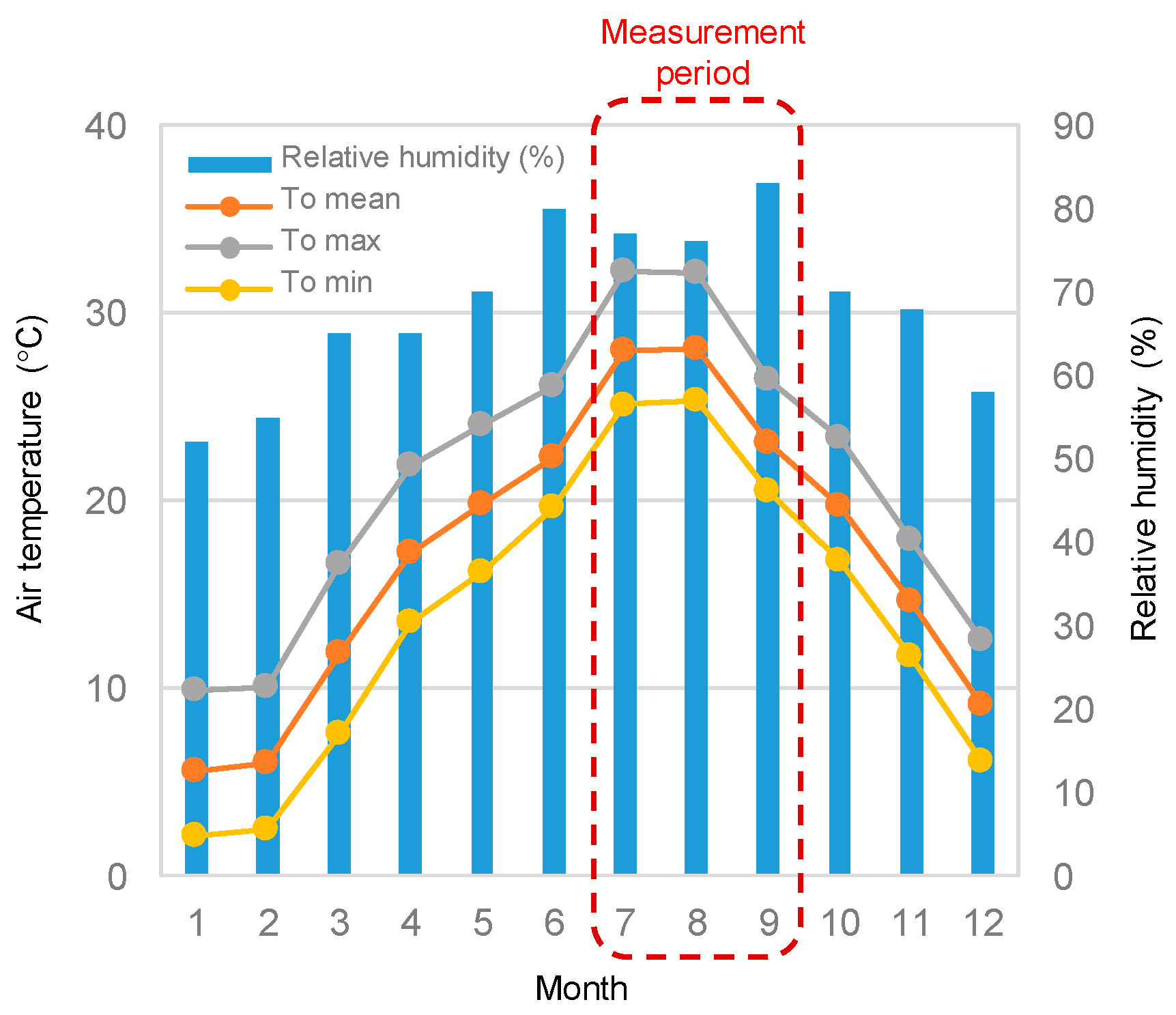
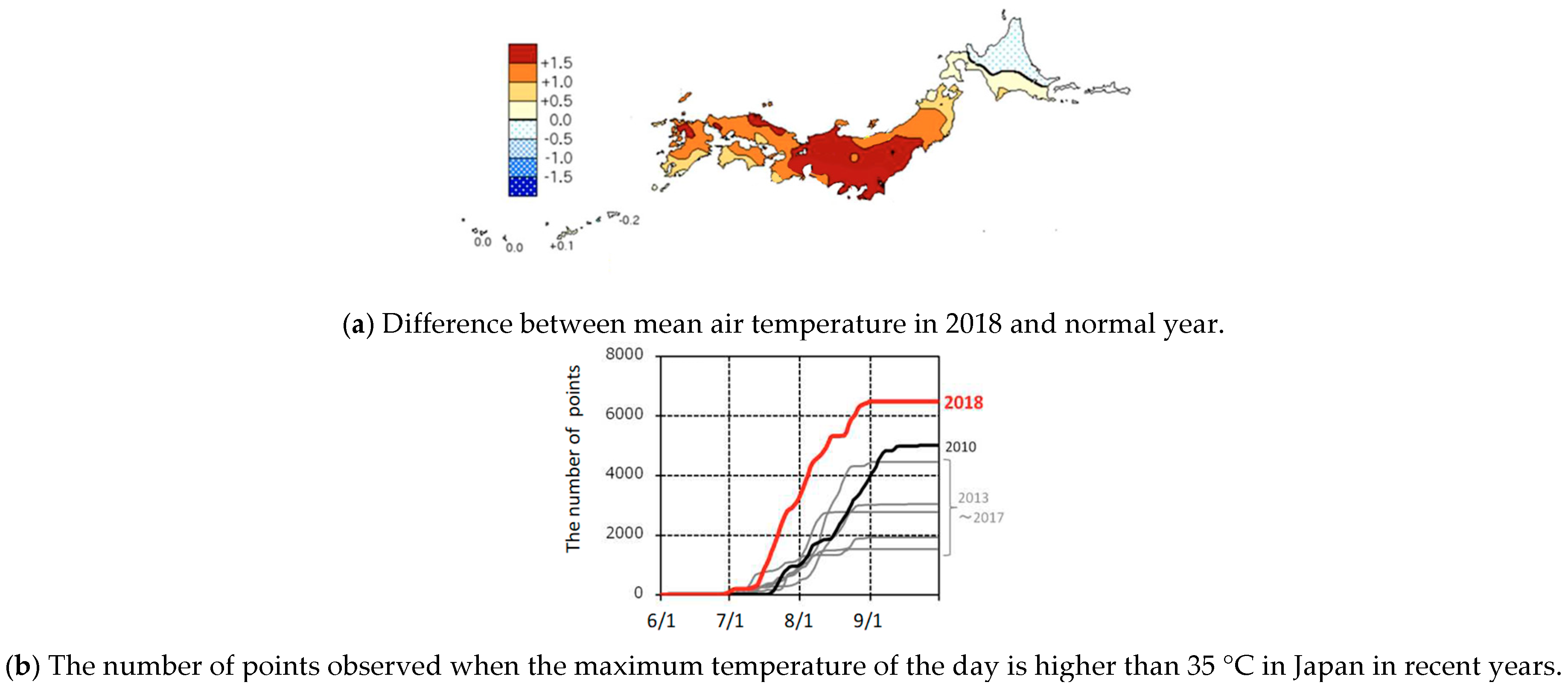

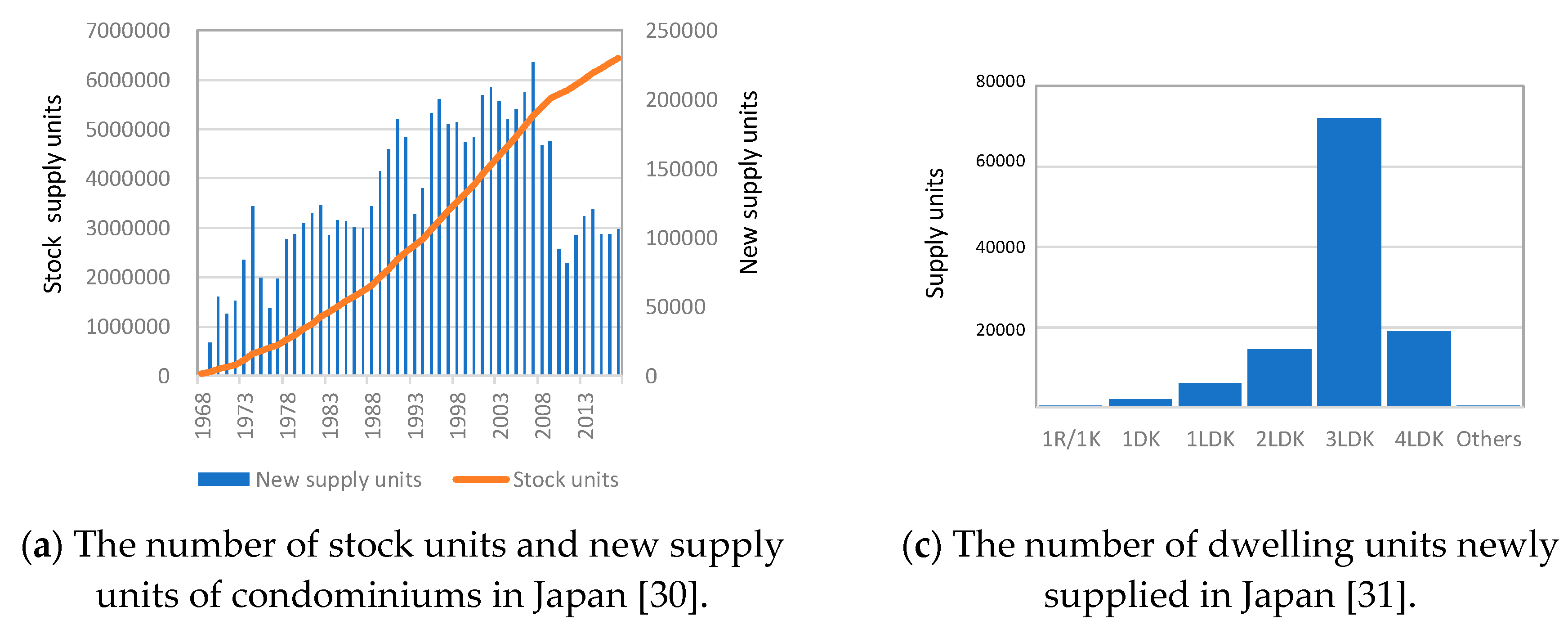
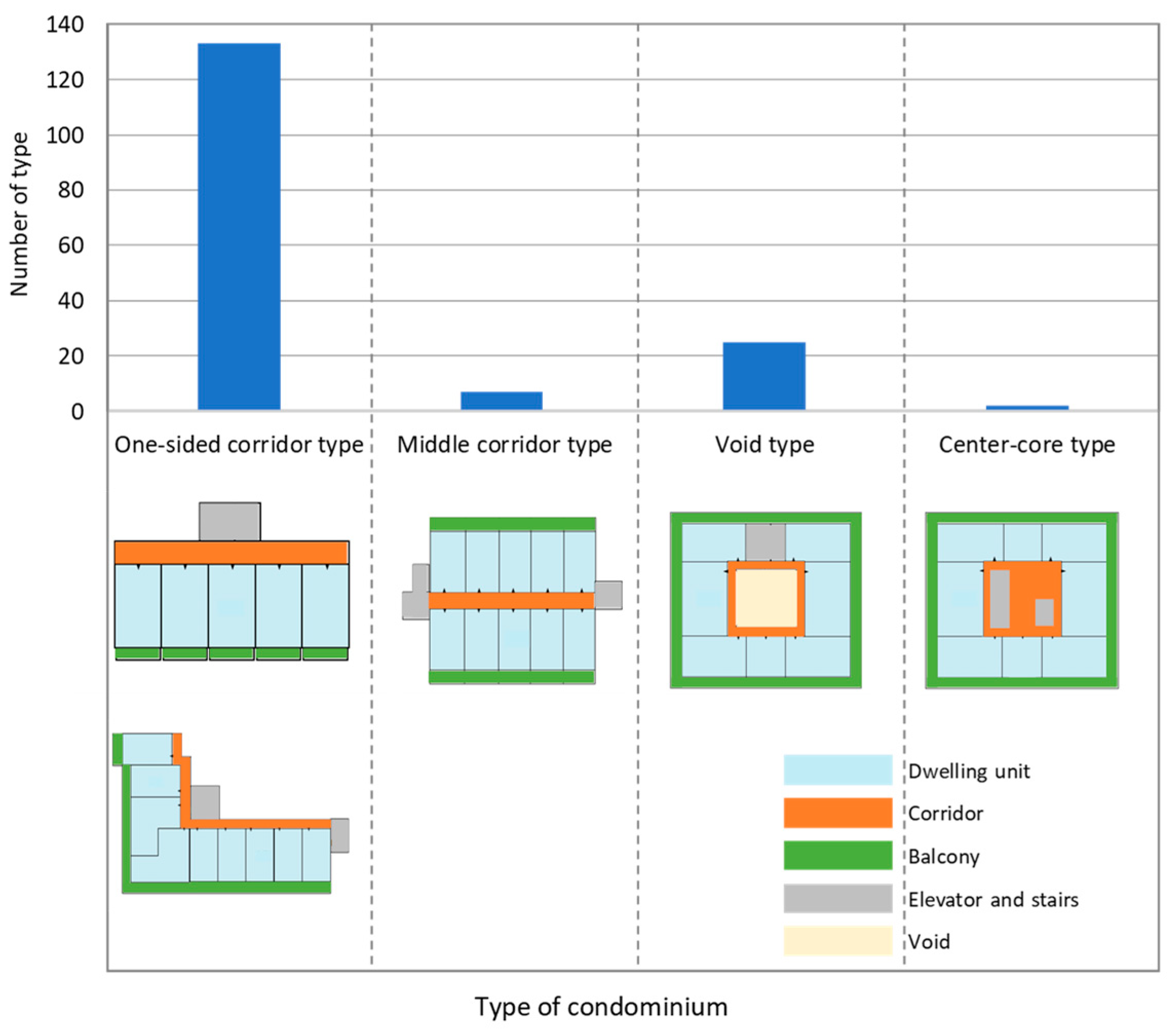


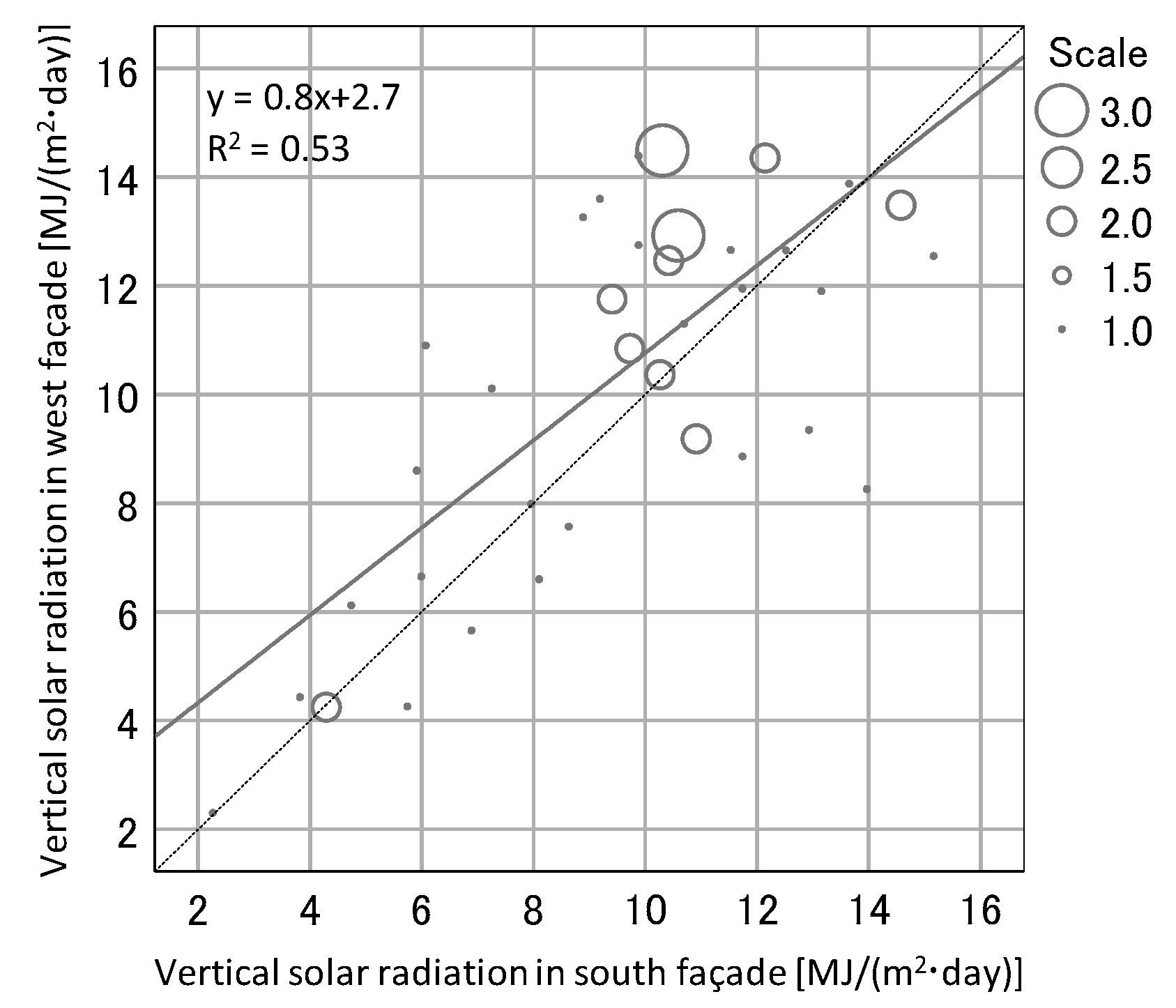



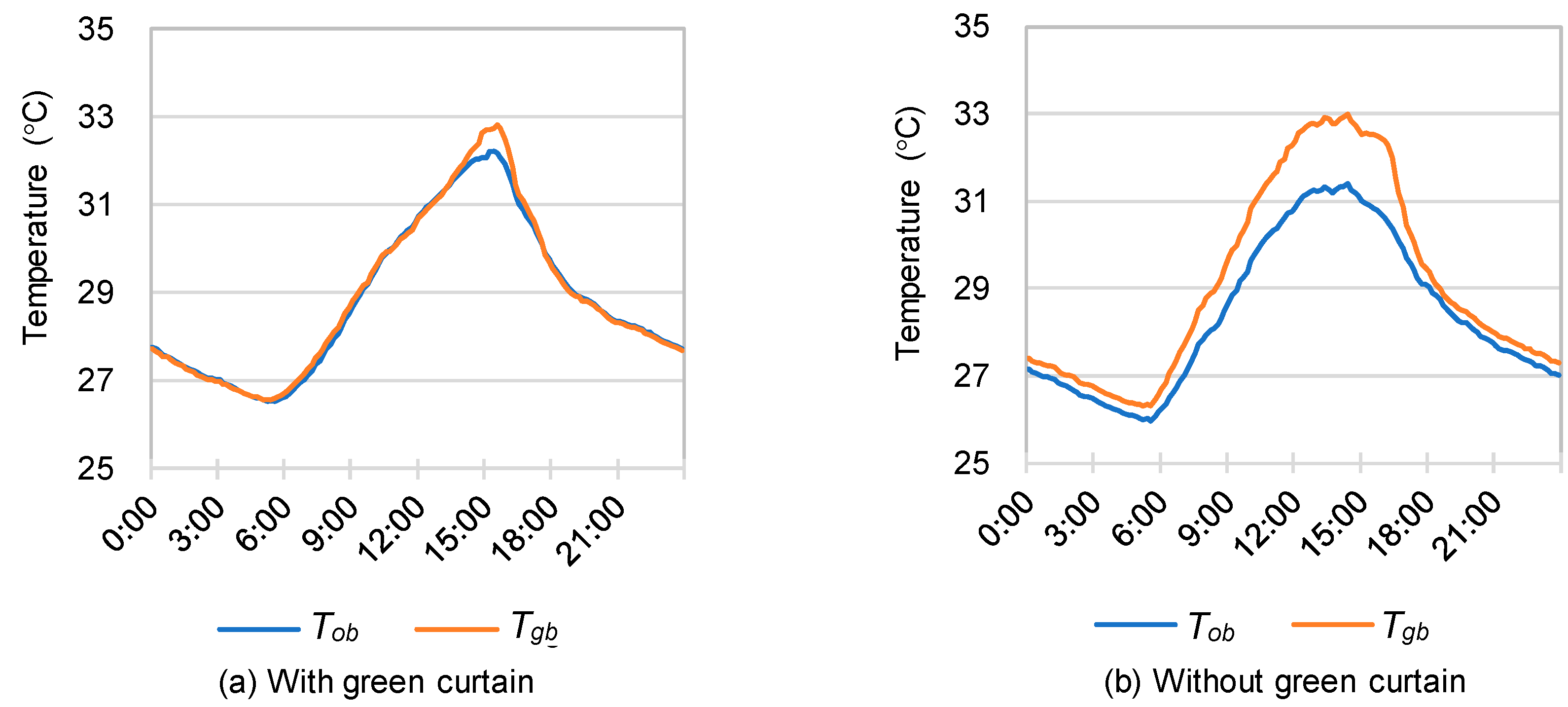
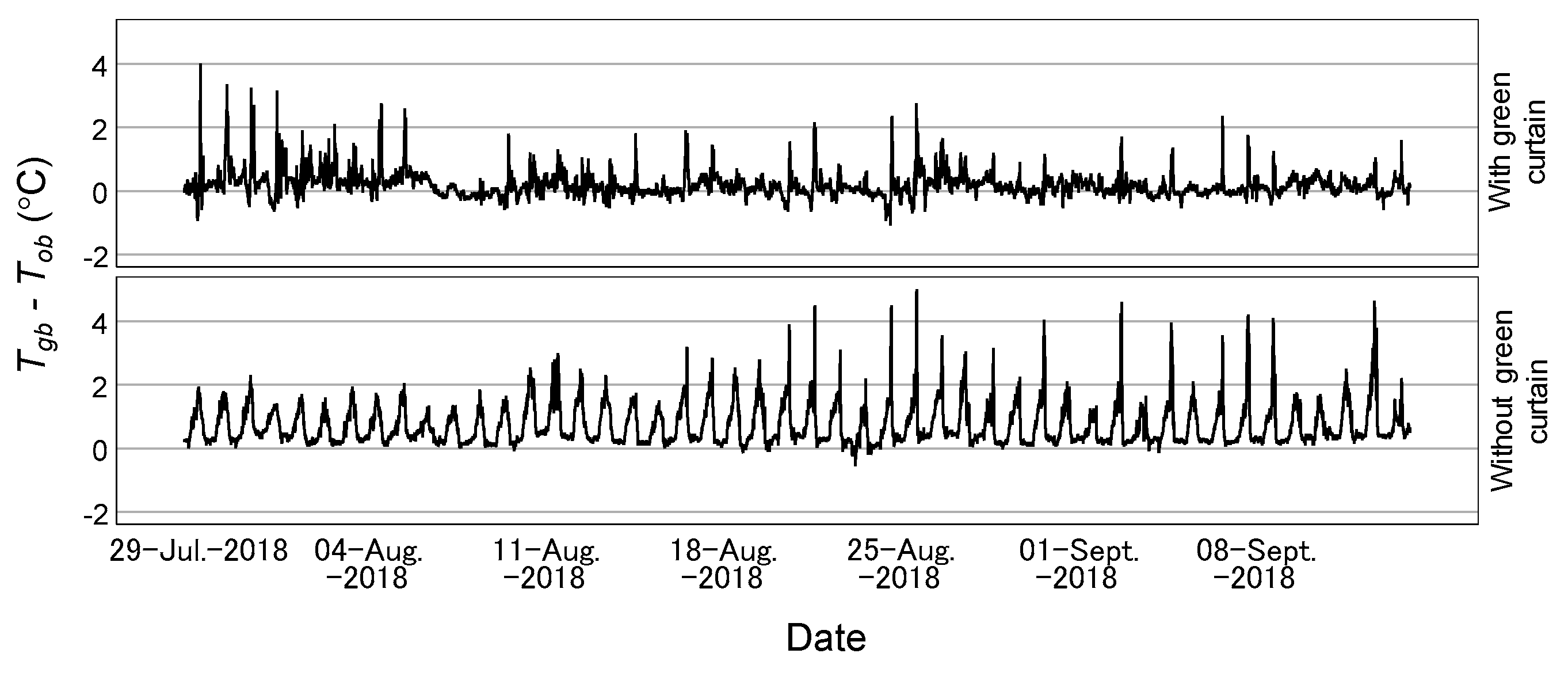
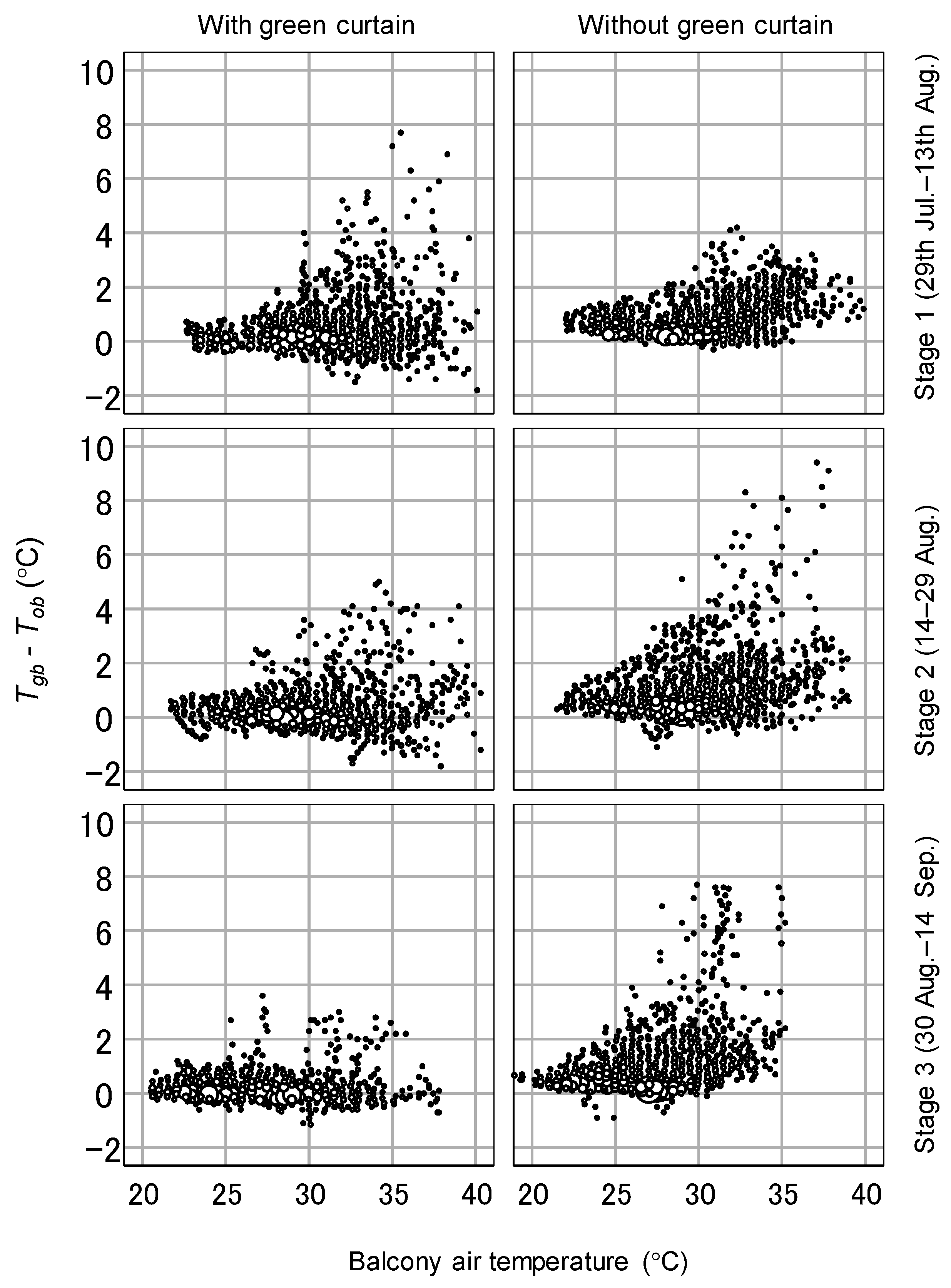
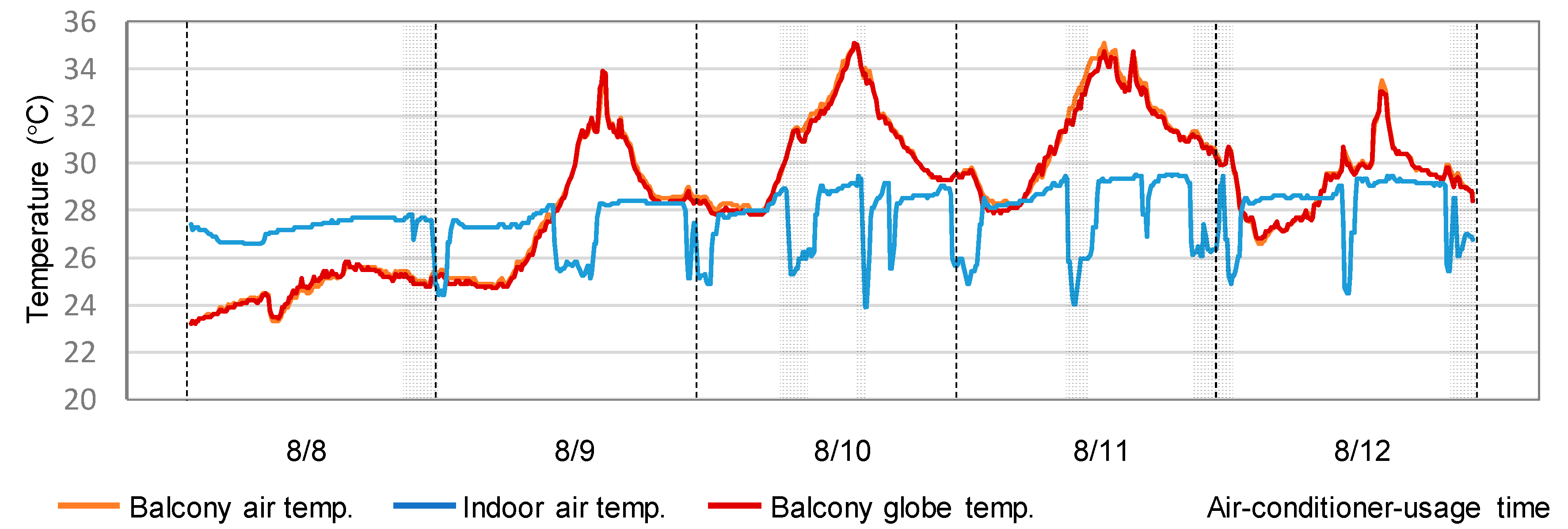
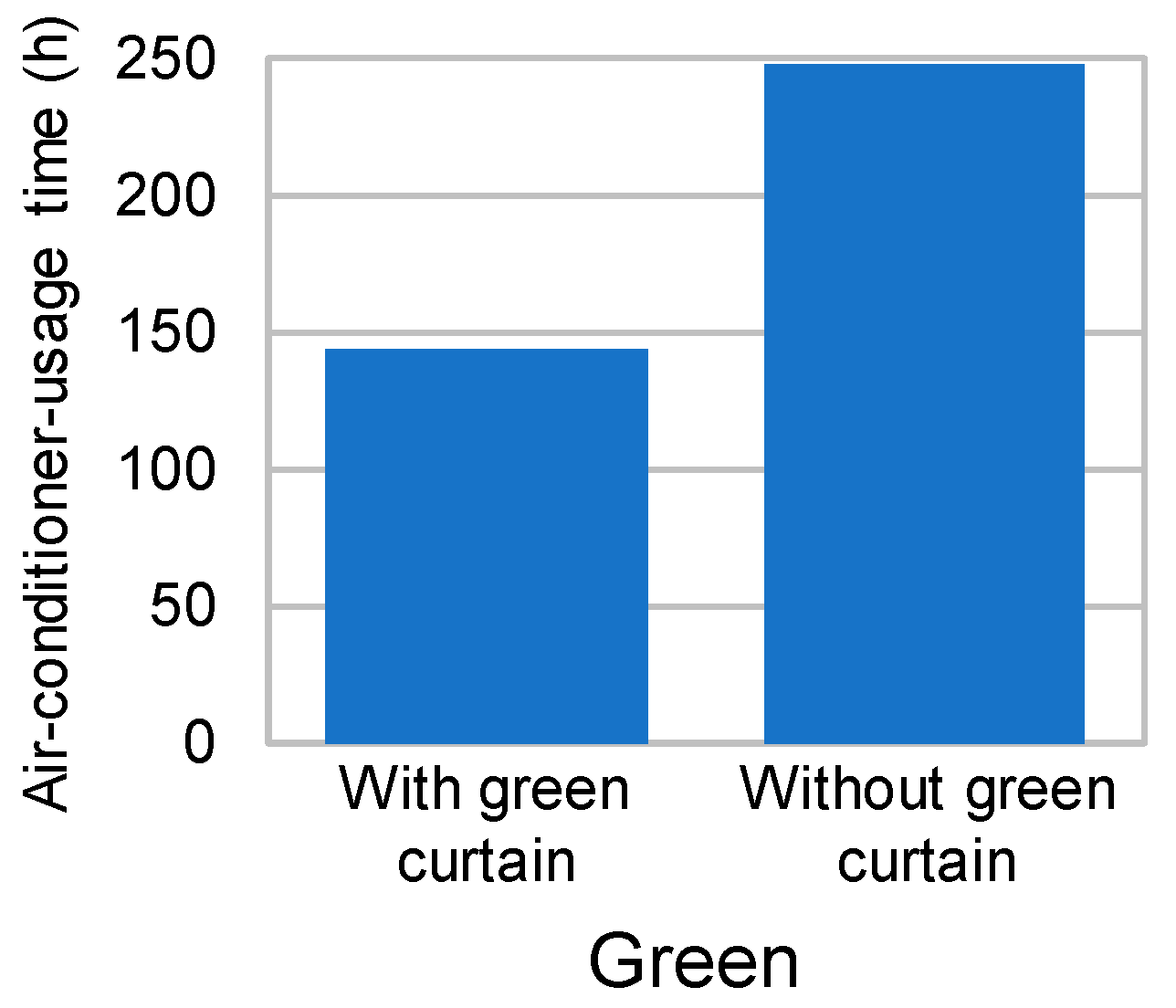
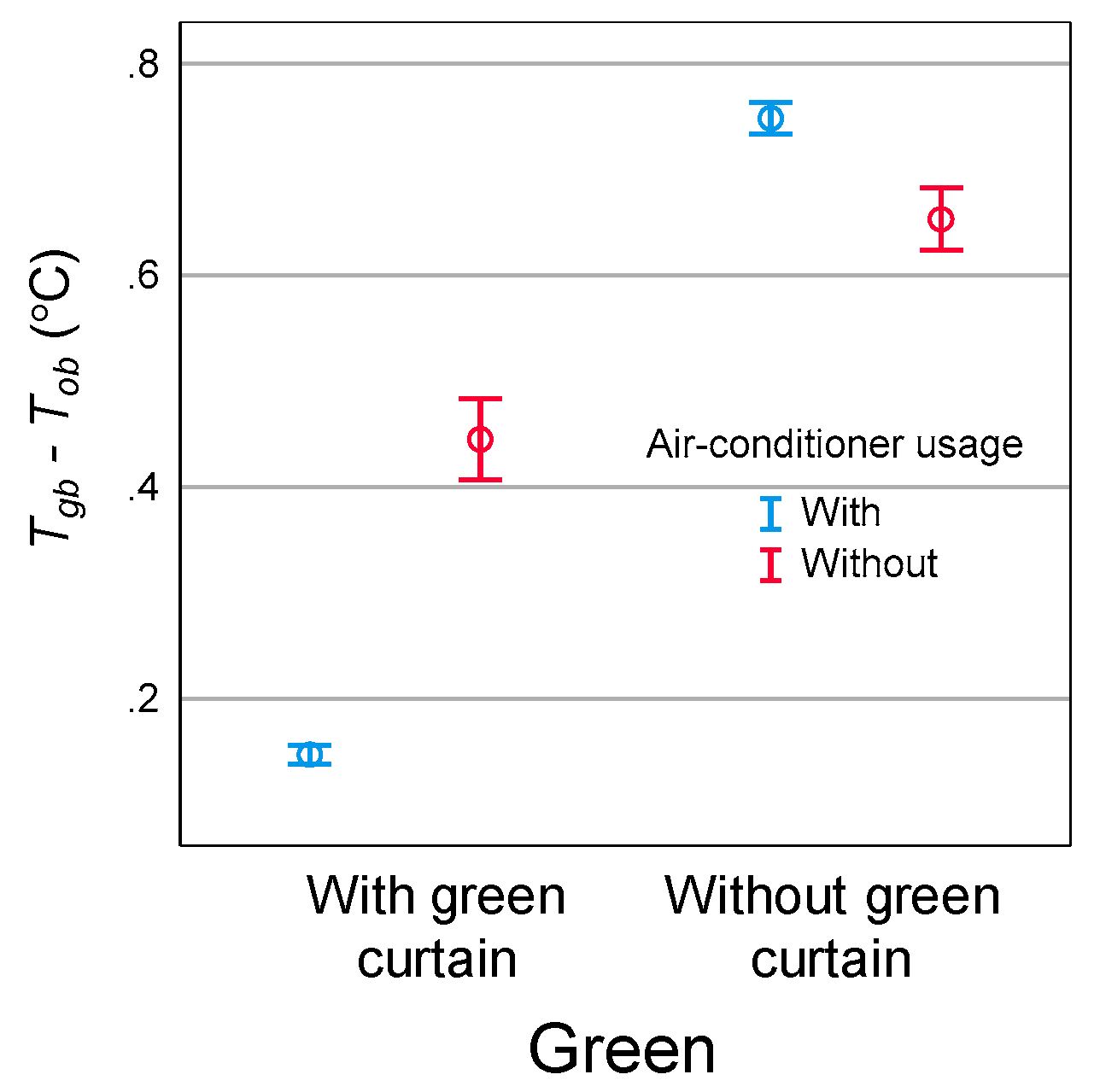
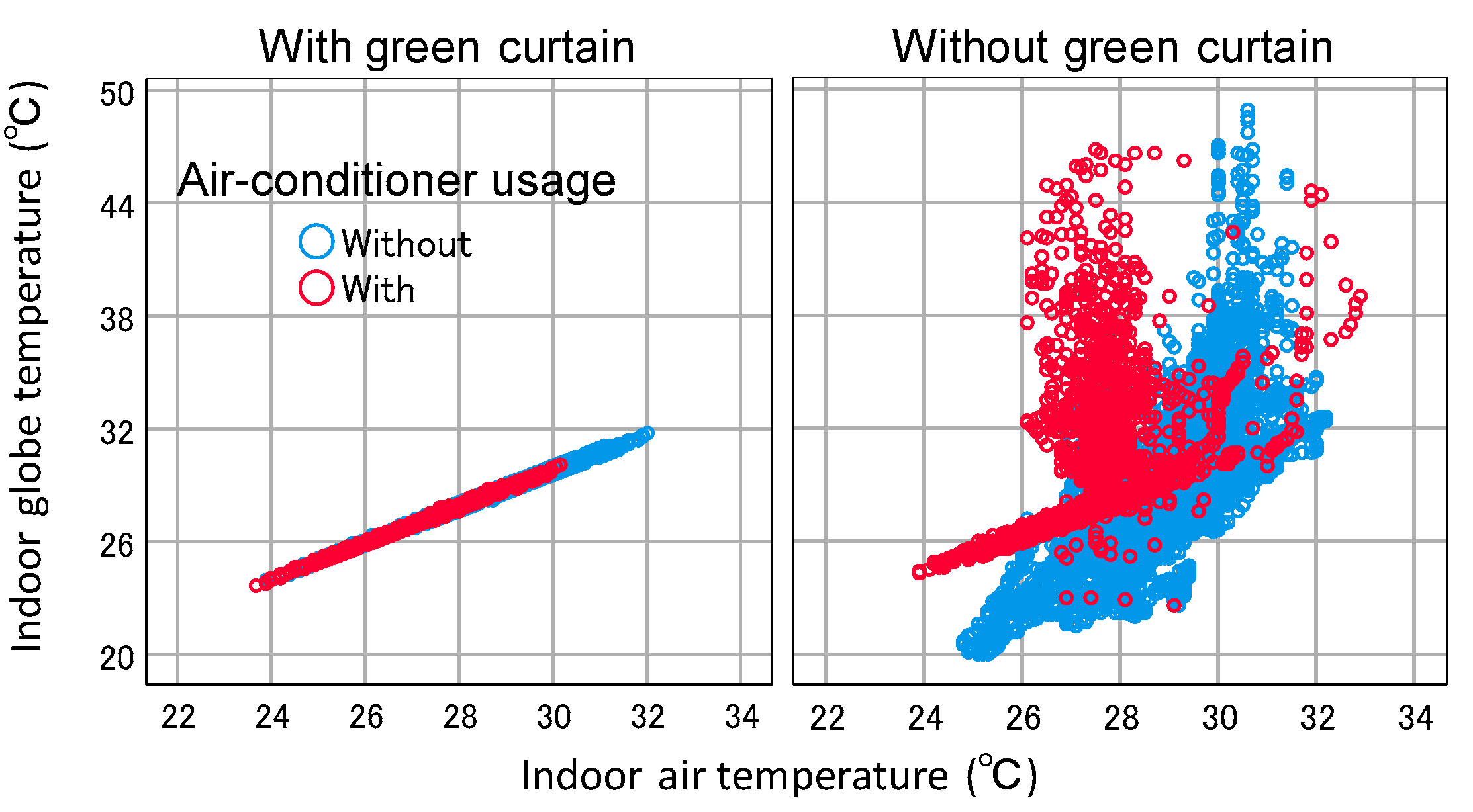
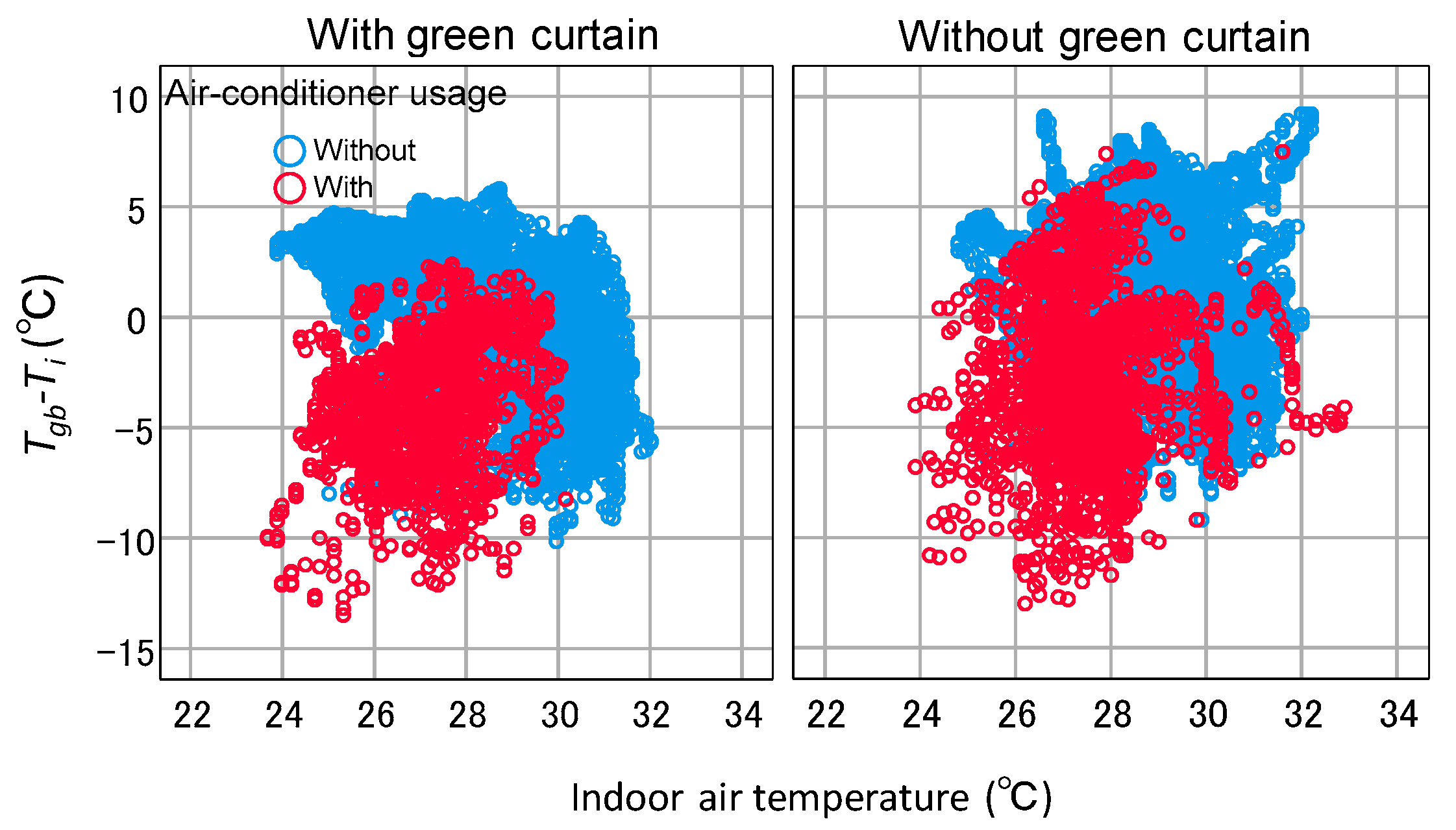

| Reference | Investigated Buildings | Investigated Space | Investigation Period | Thermal Mitigation Effect | |
|---|---|---|---|---|---|
| Maki et al. [18] |  |  | Classroom (University) | 22–26 Sep. 2011 | Indoor air temperature decreased by up to 1 °C. |
| Nakamura et al. [19] |  |  | Classroom (University) | 11 – 19 Aug. 2012 | The average indoor air temperature decreased by 0.7 °C. |
| Suzuki et al. [20] |  |  | Classroom (University) | 6–19 Aug. 2012 | The maximum indoor air temperature decreased by 4.1 °C. The balcony air temperature decreased up to 1.1 °C. |
| Suzuki et al. [21] |  |  | Classroom (University) | 4–17 Aug. 2013 | The maximum indoor air temperature decreased by 2.1 °C. |
| Narita et al. [22] |  |  | Classroom (Primary school) | 21 Aug.–10 Sept. 2006 | The maximum indoor air temperature decreased by 4.0 °C. |
| Okushima et al. [23] |  | Institute | 23 Jul.–8 Aug. 2012 | The maximum indoor surface temperature decreased by 4.0 °C. | |
| Igarashi et al. [24] |  | Condominium | 21 Jul.–28 Aug. 2007 | The maximum indoor air temperature decreased by 3.0 °C. | |
| Kato et al. [25] |  |  | Condominium | 8 Aug.–16 Sept. 2011 | Green curtains tend to be cooler than bamboo blinds. |
| Green Curtain | ID | Floor | Orientation of Balcony | Horizontal Position of Flat | Family Number | Age (year) | ||
|---|---|---|---|---|---|---|---|---|
| Husband | Wife | Child | ||||||
| With | G1 | 2 | West | North corner | 2 | 37 | 35 | - |
| G2 | 5 | West | South corner | 2 | 33 | 34 | - | |
| Without | N1 | 3 | South | Southeast corner | 3 | 36 | 32 | 3 |
| N2 | 6 | South | Southeast corner | 3 | 39 | 38 | 3 | |
| Trade Name | Measurement Variable | Range | Accuracy |
|---|---|---|---|
| TR74Ui | Air temperature | 0–55 °C | ±0.5 °C |
| TR-52i | Globe temperature | −20–80 °C | ±0.3 °C |
| Tgb-Tob (°C) | 1st Stage | 2nd Stage | 3rd Stage | |||
|---|---|---|---|---|---|---|
| with Green Curtain | without Green Curtain | with Green Curtain | without Green Curtain | with Green Curtain | without Green Curtain | |
| Number | 4608 | 4608 | 4608 | 4608 | 4608 | 4608 |
| Average (°C) | 0.3 | 0.7 | 0.2 | 0.8 | 0.1 | 0.7 |
| S. D. (°C) | 0.7 | 0.6 | 0.6 | 0.9 | 0.4 | 0.9 |
© 2020 by the authors. Licensee MDPI, Basel, Switzerland. This article is an open access article distributed under the terms and conditions of the Creative Commons Attribution (CC BY) license (http://creativecommons.org/licenses/by/4.0/).
Share and Cite
Abe, H.; Rijal, H.B.; Hiroki, R.; Iijima, K.; Ohta, A. Thermal Mitigation of the Indoor and Outdoor Climate by Green Curtains in Japanese Condominiums. Climate 2020, 8, 8. https://doi.org/10.3390/cli8010008
Abe H, Rijal HB, Hiroki R, Iijima K, Ohta A. Thermal Mitigation of the Indoor and Outdoor Climate by Green Curtains in Japanese Condominiums. Climate. 2020; 8(1):8. https://doi.org/10.3390/cli8010008
Chicago/Turabian StyleAbe, Hiroto, Hom B. Rijal, Ryoga Hiroki, Kentaro Iijima, and Akira Ohta. 2020. "Thermal Mitigation of the Indoor and Outdoor Climate by Green Curtains in Japanese Condominiums" Climate 8, no. 1: 8. https://doi.org/10.3390/cli8010008
APA StyleAbe, H., Rijal, H. B., Hiroki, R., Iijima, K., & Ohta, A. (2020). Thermal Mitigation of the Indoor and Outdoor Climate by Green Curtains in Japanese Condominiums. Climate, 8(1), 8. https://doi.org/10.3390/cli8010008






